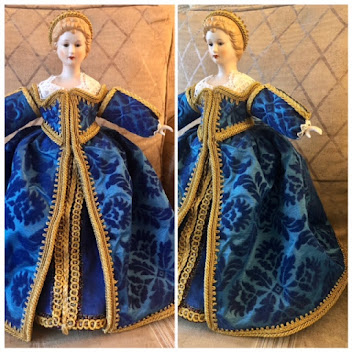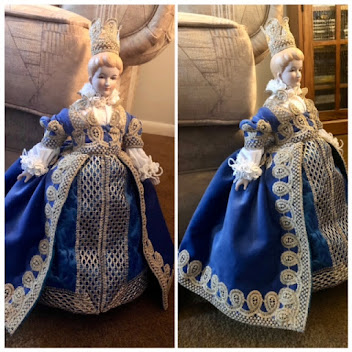Haven’t touched upon the topic in a while, the historical significance of the English Ladies Waistcoat. The ladies waistcoat is noted around 1550-1600’s England. Its a short jacket like garment meant to be worn over a kirtle (dress) and petticoats (underskirts) for the ladies.(TT Pg 41) Many made of linen, flannel(wool) and silk, these were normally lined garments but not always worn for warmth and modesty (QEWU pg 145) The waistcoat was worn by all classes, from royalty to peasant. Noted various decorated waistcoats are found in Queen Elizabeth wardrobe accounts many of silk with embroidery and other fine lace and metalwork (QEQU pg 9.) Depending in the materials and decoration, one would know the station of the person who owned the garment.
There were particular patterning cuts for men's which varies from women's waistcoats. So by looking carefully one would know which sex it was meant. (TT pg84,58) The ladies are cut in a particular way to accommodate the fullness of the hips. Using godets front and back just under the waist. Alternatively a peplum like cut to the fullness of the waist, would accommodate a growing belly depending on the pattern. (TCA vol 160) The men's are more angular and belly is shaped differently and worn over a shirt and doublet, which was tied on to under-hose.(TT pg58)
My waistcoat is made of woven wool fabric and lined in cotton linen blend interlined in wool. Queen Elizabeth’s Wardrobe Unlock’d mentions blended fiber linings on pg 9. I spun the weft single ply in gray Ramie wool, woven the ramie wool fabric in a tabby weave, patterned the garment piecing all 6 yards of wool 12” fabric, then sewed it together. Many of surviving examples of waistcoats are black-work and ploy-chrome silk embroidery on linen, those of lower classes wouldn't be able to afford such a luxury so would need something more in line with their socio-economic standing.
I used the simplest tabby weave as I know it historically goes back to ancient times, also thought
it was class appropriate. As it a simple weave though worked in 3 colors appears more complicated pattern in the fabric was to work. The ply of the brown and white weft wool made this awesome pattern as the subtle grey winks through. The significance of the colors of wool that these are the ones naturally available from the lucrative wool trade in England.
 |
| Layton Jacket with Portrait of Margaret Layton Victoria& Albert Museum London, England. |
Reinforcing the seams with heavier wool felt and decorated with couched wool yarn same colors as the waistcoat. Turned out to be quite a thick and heavier garment, which is great since they historically are worn for warmth (QEWU pg145) When I was envisioning the end product of all this cottage craft, I detailed it for a middle class English lady for unseasonable damp and cold weather.
In conclusion found it to be thicker that expected but wasn’t unusual for some bulk depending on lining choices(QEWU pg 9). In my outdoor test wearing at Lewisburg Arts festival, a cool to mild warm Pennsylvania spring day with a breeze among the damp. I felt warm and dry, not at all hindered by the thickness but was able to feel the breeze so it kept warmth but also allowed the sweat to wick and keep dry. A functional, practical, handmade garment that it also pleasing to wear. Would call this more than a middling success.
Bibliography:
QEWU- Queen Elizabeth Wardrobe
Arnold, Janet. Queen Elizabeth's Wardrobe Unlock’d. Maney Publishing, 1988. ISBN: 9781909662537
TT- The Tudor Tailor
Malcolm-Davies, Jane and Mikhaila, Ninya. The Tudor Tailor: Reconstructing 16th Century Dress. Costume and Fashion Press, 2006. ISBN: 9780896762558
TCA- The Compleat Anachronist
Kratts, Aimee. The Compleat Anachronist: A Survey of Late Sixteen/Early Seventeenth Century Embroidered Jackets. Vol 160. July 2013.
Visual Bibliography:
Margaret Layton Portrait (1620) oil on Oak Panel. Victoria and Albert Museum item E.214-1994
Margaret Layton Waistcoat. 1610-1615 made, 1625 altered, Victoria and Albert Museum item T.228-1994







